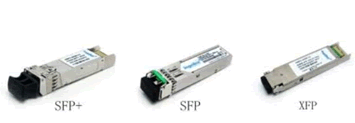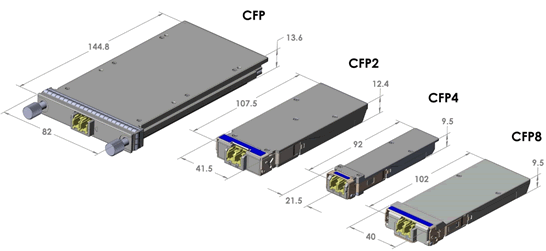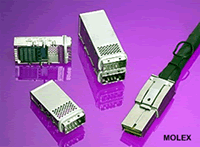SFP Connectors: Always New and Improving
The acronyms may change, but new SFP connectors continually emerge with enhanced port densities and data rates.
For anyone who does not work with communication standards, protocol specifications, or data rates on a daily basis, navigating the world of telecom acronyms as it relates to interconnect can be a daunting task — sort of like playing scrabble in a foreign language. Although all of these interconnects and their corresponding acronyms have evolved over time, in the last two decades, with our quest for greater speed and density, their number continues to grow.
An area that has undergone a significant transformation in available options is that of the small form-factor pluggable (SFP) connector. Used in a plethora of high-speed network and computing applications, the basic small-form factor connector has spawned a number of new pluggable interfaces that are smaller and faster — all, of course, with their own unique acronym!
The Connector of Choice in Fiber Optic and Ethernet High-Speed Networking Systems
Designed to replace the much larger gigabit interface converter (GBIC) connector in fiber optic and Ethernet high-speed networking systems, the SFP connector was first introduced in early 2000. The SFP has the ability to handle up to 4.25Gb/s and is half the size of a GBIC. This allowed it to quickly become the connector of choice for system administrators who liked the idea of being able to significantly increase their output per rack. Based on the IEEE 802.3, SFF-8472 protocol specification, one additional difference between the GBIC and SFP was that the fiber optical interface in a GBIC was a subscriber/standard connector (SC) and the interface in a SFP was the Lucent connector (LC) interface. Physically half the size of an SC connector, the LC not only offered the advantage of greater port density, but also lower insertion loss than the SC and a latching system similar to that of the popular RJ-45 connector. The SFP connector also supports Gigabit Ethernet, Fibre Channel, Synchronous Optical Network (SONET) and other communication standards.
Also using an LC interface, but designed specifically for 10G applications, the XFP (10G small form-factor pluggable) connector was announced shortly after the SFP connector. Like the SFP, the XFP is hot swappable, protocol independent, and was covered by a multi-source agreement (MSA); although, the MSA is now obsolete. The XFP is designed to support 10 Gigabit Ethernet (GbE), 10 Gigabit Fibre Channel (GFE), SONET, Optical Transport Network (OTN), and other communication standards.
An extension of the SFP connector, the SFP+ (or SFP10) was first introduced in 2006. Like the XFP connector, the SFP+ is designed to support data rates up to 10Gb/s. The SFP+ is based on IEEE802.3ae, SFF-8431, and SFF-8432 protocol specifications and, like its predecessor, supports Fibre Channel, 10GbE, SONET, OTN, and other communication standards. The primary difference between an XFP and a SFP+ is the size and power consumption. The SFP+ is similar in size to the SFP connector, but because it performs fewer functions (moves them to the motherboard) than the XFP, requires less power. Also, while the XFP is optic only, the SFP/SFP+ are both copper and optical.

The Third Generation of SFP Connectors
The SFP28, which is the third generation of SFP connectors, is designed for 25G performance. The connector offers increased bandwidth, superior impedance control, and less crosstalk than the SFP10. The connector is also backwards compatible with the SFP10, meaning an SFP28 can be plugged into an SFP10 port and vice versa, but plugging an SFP10 into an SFP28 port will not get you 25Gb/s data rates.
By combining four SFP+ (SFP10) connectors into a single transceiver, the quad-channel SFP (QSFP) connector was spawned. This connector, designed for 40GbE applications, offers many of the same advantages as the SFP+, but just like the SFP+ when it replaced the GBIC, offers much greater density by combining four ports into one. This combination allows equipment designers to more than double their port panel density, reducing overall system cost. The next generation of QFSP connectors, the QFSP28, took this one step further, combining four SPF28 connectors to achieve a data rate of 4x28Gb/s. QSFP28 transceivers are designed to support Serial Attached SCSI, 40G Ethernet, 20G/40G Infiniband, and other communications standards. Today, most QSFP connectors have been replaced with QSFP28 versions.
100Gb/s and Beyond
In 2010, the 100G C form-factor pluggable (CFP) connector was introduced. Similar to other form-factor pluggable connectors, the CFP is covered by an MSA and accepts all CFP MSA compliant transceivers. The CFP interface is optical only and supports both single-mode and multi-mode fiber, as well as a variety of data rates, protocols, and link lengths. Because the CFP was developed for 100GbE systems, it can support a wide range of 40 and 100Gb/s applications, such as 40G and 100GbE, OC-768/STM-256, optical transport unit (OTU)3, and OTU4. Although designed after the SFP interface, the CFP connector is much larger than even the QSFP28 and typically used in long-reach applications.

The CFP MSA currently specifies three versions: CFP, CFP2, and CFP4. The CFP connector has a contact pitch of 0.8mm, while the CFP2 and CFP4 both specify a 0.6mm contact pitch. All three versions use single-mode and multi-mode cable as their media, with the key difference in addition to contact density and size being maximum power consumption per module. The CFP connector is 8-32W per module, while the CFP2 is 3-18W and the CFP4 is 1.5-9W per module. An additional version, the CFP8 is still in development. This 400Gb/s optical transceiver is designed for Ethernet and other applications, and it supports eight times and four times the bandwidth-density of CFP and CFP2 form factors, respectively.
Support for the Highest-Density Requirements
 To support the high-density requirements of data centers, an internal working specification for a mini multilane shielded integrated connector, the CXP, was submitted to the CFP MSA working group in 2016. Capable of meeting the interface requirement for the operation of Infiniband QDR (120G 12×10), as well as 100GbE and proprietary links between systems collocated in the same facility, the CXP has a width of 27mm and length of 45mm.
To support the high-density requirements of data centers, an internal working specification for a mini multilane shielded integrated connector, the CXP, was submitted to the CFP MSA working group in 2016. Capable of meeting the interface requirement for the operation of Infiniband QDR (120G 12×10), as well as 100GbE and proprietary links between systems collocated in the same facility, the CXP has a width of 27mm and length of 45mm.
In January of 2017, Rev 2.4 of the microQSFP MSA specification was developed. Focusing on a form factor that supports up to four electrical channels, and that offers high system density and a high performance thermal solution, the microQSFP connector is designed to support four 28Gb/s signal channels in individual  channels in 10, 25, 50, and 100GbE applications, and 16, 32, and 128GFC applications. According to the MSA, “In a two-row implementation, the microQSFP will fit at least 48 ports on a line card and, in a three-row implementation, at least 72 ports can be accommodated. When each lane is used as an independent channel, it allows microQSFP to offer four times the port density of SFP and, when used in an aggregated lane mode, to offer one-and-a-half times the port density of QSFP.”
channels in 10, 25, 50, and 100GbE applications, and 16, 32, and 128GFC applications. According to the MSA, “In a two-row implementation, the microQSFP will fit at least 48 ports on a line card and, in a three-row implementation, at least 72 ports can be accommodated. When each lane is used as an independent channel, it allows microQSFP to offer four times the port density of SFP and, when used in an aggregated lane mode, to offer one-and-a-half times the port density of QSFP.”
More Improvements Unveiled in 2017
The latest iteration of pluggables is the octal small form factor pluggable (OSFP) recently announced at DesignCon 2017. It is designed to deliver eight channels of 50Gb/s to support 400Gb/s applications. Thirty-two OSFP ports on a 1U panel provides 12.8Tb of output.
Lest you think we have run out of acronyms, others worth mentioning include the zSFP, zQSFP, and zQSFP+ (zQSFP28), along with versions that offer thermally enhanced cages for improved airflow and better heat dissipation. Of course, we all know this is not the end of our collection of small form-factor pluggable acronyms. As long as there is interest in improving port density and signal rate, new versions and improved versions of existing small form-factor pluggable connectors will be developed.
Recently posted:
[related_posts limit=”10″]
- Wire & cable cutting services - March 3, 2024
- Belden – REVConnect RJ45 Connectors | First Look - March 3, 2024
- Molex, LLC – 5G25 Series 5G mmWave RF Flex -to-Board Connectors | First Look - March 3, 2024






